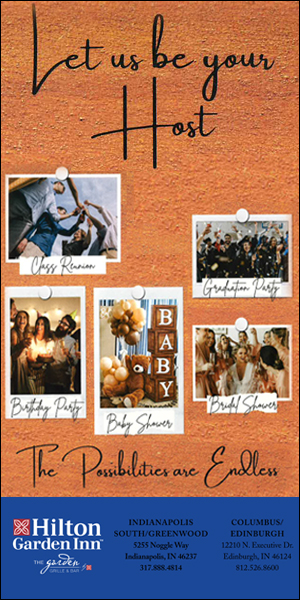
State Chamber of Commerce promotes Hoosier manufacturing success
By Jenny Elig
You may or may not be well aware of Indiana’s rich manufacturing past. But did you know about its rich manufacturing present?
Awareness is the goal of the Indiana Chamber of Commerce’s Coolest Thing Made in Indiana contest, announced in the spring and organized to celebrate the long manufacturing history and underscore the ubiquity of the Hoosier state’s manufacturing present. After all, to this day Hoosier makers are busy churning out goods in all corners of the state, says Rebecca Patrick, senior vice president of communications at the Indiana Chamber of Commerce. “Really, it’s everywhere, in every county in the state,” she says.
The contest is for makers across all industries. Winners will be chosen through public voting; each winner advances to the next round, all the way up to the final four teams and an ultimate Coolest Thing Made in Indiana champion. Although company headquarters do not need to be located in Indiana, to be eligible the product must be manufactured in Indiana. Each company can only have one nominated product, and the product must be made using a process from any manufacturing sector. For more information on the Coolest Thing Made in Indiana contest, visit the Indiana Chamber of Commerce website, indianachamber.com.
You might know some of the list: ketchup, recreational vehicles, pharmaceuticals and medical devices, chocolate, caskets, popcorn, furniture, shaving cream and gummy bears. Shall we continue? Since the Industrial Revolution, Indiana has been a manufacturing force, a quiet but steady source of made goods.
“There is a lot of history there. It’s broad and it’s deep. It’s quirky; it’s interesting,” says Katherine Gould, curator of cultural history at the Indiana State Museum.
We didn’t start the fire
The words “Indiana manufacturing” might have you thinking of farming and agriculture right off the bat. It’s true, the history starts there. “Milling, of course, is probably the earliest industry in Indiana when settlers come,” Gould says. “Our agricultural story isn’t just growing corn and soybeans. We used to have a huge manufacturing sector and actually making the things to do the agriculture, so agricultural and farm equipment manufacturing.” Indiana manufacturers produced steam engines, plows, tractors, threshers, hullers and roller mills. Indianapolis-based Nordyke Marmon & Co. was one of the leading concerns in making roller mills. In Evansville, the Vulcan flour company launched thousands of loaves, and LaPorte’s Rumley made tractors.
And then there were the manufacturers that spun off from agriculture. Universal-Boyer Fire Apparatus, originally known as Obenchain-Boyer Co. and Boyer Fire Apparatus Co., was started after founders’ John Obenchain and Stephen Boyer’s jointly owned flour mill burned down. “A lot of mills did because the dust generated from milling grain is actually highly combustible,” Gould says. The pair rebuilt their business, reborn as a chemical fire extinguisher manufacturer. The company operated from 1888 to 1988.
A-Tisket, A Casket
Even when farming was the main game in town, Indiana manufacturing wasn’t solely centered on agriculture, Gould says. “What I found most interesting and what people I think don’t realize is just the breadth of Indiana manufacturing history,” she says. Indiana had the resources to support burgeoning industries. “Cheap land was available. In the late 19th, early 20th century we had an abundant labor pool and then easy access to transportation.”
This abundant labor pool made Elkhart the musical instrument capital of the world and put Batesville on the casket-making map. Outside of Cincinnati, a heavy German immigrant population in Madison supplied the Schrader Saddletree factory with plenty of skilled craftspeople to produce saddle trees.
“There’s more than corn in Indiana, and I think with Indiana manufacturing history there’s a lot more here,” Gould says.
Here’s where things get hairy
That Indiana was and continues to be a force in the automobile manufacturing industry comes as no surprise to Marianne Sheline, Indiana Historical Society director of external engagement and special initiatives. A born and bred Hoosier, Sheline grew up with our state’s history and knows well Indiana’s auto industry narrative. “We’ve had over 100 different brands of cars manufactured in Indiana,” Sheline says. From Elwood Haynes’ Kokomo-made horseless carriage, built and tested in 1894, to the Studebaker to the Stutz Bearcat, Hoosiers have been keeping Americans on the road throughout the life of the auto industry.
Additionally familiar, but one that would create a noticeable void if not mentioned, is the story of Madam C.J. Walker, who based her hair care product production in Indianapolis in the early part of the 20th century. Although Walker would eventually settle on the East Coast, she is known for creating this workforce of African-American women who sold her products. Walker is known for “improving the work conditions for Black women and giving them a way to move up in the world,” Sheline says. “And she’s often listed as the first African-American self-made millionaire.”
Loud and clear
Indiana manufacturing played a role in pop culture through RCA, Gould says, for the volume of televisions and radios that came out of Indiana and ended up in homes across America. RCA’s rise and fall are one example of the “birth and death of the consumer product industry in America,” she says.
Although RCA’s presence in Indiana has petered out, the RV industry is going strong, Sheline says. One of every two RVs on the road today was made in Elkhart. The industry, Sheline says, sprang up organically in the 1930s. By the 1940s, Elkhart was dubbed the “Trailer Capital of the World.”
Eat it up
When natural gas was discovered, the Indiana Glass Trail was born, with Ball Mason jars making a large dot on the map, right in Muncie. The iconic Coke bottle’s curvy shape was the brainchild of designers at the Root Glass Co. in Terre Haute.
Wonder Bread started life as an Indianapolis-based company; the brightly colored circles on the brand’s bags were inspired by the balloon race at the Indianapolis Motor Speedway, Sheline says.
Indiana’s manufacturing past and present have a sweet side, too, which includes Merrillville’s Albanese Candy. And if any edible indulgences get to you, Alka Seltzer – first marketed by the Doctor Miles Medicine Co. of Elkhart – might help in a pinch.
“There are so many names that are still around that are definitely tracking back to the Hoosier state,” Sheline says.
Taking away more than products
Dig in just a little bit, and there are too many manufacturing stories to tell – at least in this space. Taken as a whole, Indiana’s manufacturing past and present say a lot about the state’s character.
Hoosiers might often be “downplayed a lot across the country as being, you know, down home, simple folks,” Sheline says. But Indiana’s manufacturing history “just shows how smart and innovative and resilient Hoosiers are. When there’s a problem, we find a way to fix it.”


